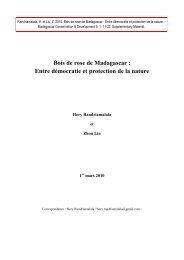Journal Madagascar Conservation - Madagascar Wildlife ...
Journal Madagascar Conservation - Madagascar Wildlife ...
Journal Madagascar Conservation - Madagascar Wildlife ...
Create successful ePaper yourself
Turn your PDF publications into a flip-book with our unique Google optimized e-Paper software.
MADAGASCAR CONSERVATION & DEVELOPMENT VOLUME 3 | ISSUE 1 — DECEMBER 2008 PAGE 32<br />
METHODS<br />
Beza Mahafaly is ecologically diverse, with a 90 ha Parcel 1<br />
comprised partially of gallery forest and bordered along its<br />
eastern limit by a small river (the Sakamena, which is dry for<br />
around seven months every year). There is also a 520 ha spiny<br />
forest (Parcel 2) approximately 10 km to the west of Parcel 1<br />
(Ratsirarson et al. 2001). Both parcels belong to the reserve, but<br />
only Parcel 1 has been fenced. Parcel 1 is considerably smaller in<br />
size than Parcel 2, and it is located near the main research camp.<br />
The fence was erected to keep cattle from entering this part of<br />
the reserve. The two are connected by a transitional dry forest<br />
corridor. Another dry forest is located near a village, Ihazoara,<br />
just southeast of Parcel 1, but that forest is not part of the<br />
reserve. Within a distance of around 20 kilometers from Parcels<br />
1 and 2 are situated 17 villages with a combined human population<br />
of over 5,700 individuals (ca. 60 % children) (unpublished<br />
records of the Commune Rurale Ankazombalala). According to<br />
the records of the Beza Mahafaly research station (the camp<br />
site, located just to the south of Parcel 1), the reserve attracts<br />
around 70 tourists and 30 researchers annually. Figure 1 shows<br />
a schematic map of the Reserve (Parcels 1 and 2) and several<br />
of the nearby villages, including Ihazoara. The forest at Ihazoara<br />
is located to the east and south of the village.<br />
Trapping occurred on a regular basis between 9 October<br />
2006 and 30 September 2007. All captures were conducted at<br />
night, when these animals are active. Four months were scheduled<br />
for intensive sampling (October, January, May, and September)<br />
and all other months were scheduled for random sampling.<br />
This schedule was established to best sample individuals at<br />
very different times during the year, including the beginning<br />
of the wet season (October) and the middle of the wet season<br />
(January), the middle of the dry season (May), and the end of<br />
the dry season (September). During the periods of intensive<br />
sampling, we set 180 Sherman traps every night at each of three<br />
forests at Beza Mahafaly, Parcel 1 (gallery, protected), Parcel 2<br />
(spiny, protected) and Ihazoara (dry, unprotected). The trapping<br />
in October extended until November 8, so each period of inten-<br />
sive capture encompassed 30 days. Sherman traps are made of<br />
aluminum (7.7 cm x 7.7 cm x 30.5 cm) with a spring - operated<br />
front door. All trapping locations were flagged and their positions<br />
recorded using GPS. During the months of intensive capture, the<br />
traps were set on every day of every week in grids measuring<br />
275 m x 225 m. They were set at distances 25 meters apart; 60<br />
trees had only one trap set at heights of one to two meters,<br />
30 had two traps set in the tree (one at ca. one meter and a<br />
second at ca. two meters height), and 30 had a single trap set<br />
in the tree (again at between one and two meters) and a second<br />
trap set on the ground near the tree’s base. The total number<br />
of traps set each night at each forest location was 180, equaling<br />
5,400 trap - nights per month of intensive capture at each<br />
location. Traps were baited with banana at 1730h and checked<br />
at 0500 - 0600h in the morning. When they were occupied, the<br />
animals were brought to the camp for measurement (weight,<br />
head length, body length, tail length, total foot length, and ear<br />
length), and for the collection of biological samples (blood, fur,<br />
ear tissue, feces, external parasites). To facilitate the collection<br />
of morphometric data and the marking procedure (cutting small<br />
pieces of ear tissue), individuals were temporarily anesthetized<br />
using appropriate dosages of Telazol ® (which combines the<br />
anesthetic drug tiletamine HCl with the benzodiazepine anxiolytic<br />
drug, zolazepam HCl). All individuals were released in the<br />
afternoon or early evening at the site of capture.<br />
During the eight months slotted for random sampling,<br />
five smaller grids (each measuring approximately 20 x 20<br />
m 2 ) were set at randomly selected places within each of the<br />
three forests. Nine traps were set in each of the five grids at<br />
heights of one to two meters (spaced ca. 10 m apart) and three<br />
additional traps were set on the ground. Trapping occurred for<br />
five days per week for three consecutive weeks (for a total<br />
of 900 traps per forest per month). Trapping locations were<br />
flagged and their positions recorded using GPS. The above<br />
procedures were followed whenever individuals were found in<br />
the traps. At the end of each of the eight months devoted to<br />
random sampling, we conducted intensive sampling following<br />
FIGURE 1. Map of Beza Mahafaly showing the locations of Parcel 1, Parcel 2, Ihazoara village (with forest to the south of the village) and other nearby<br />
villages.



